Lessons Learned from a Summer of Banding American Oystercatchers
by Emmy Casper, Wildlife Biologist
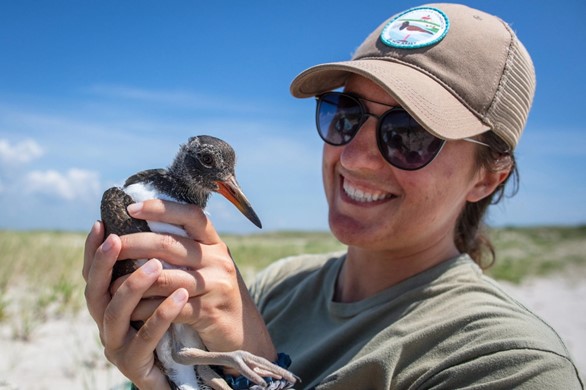
Those who have followed CWF’s work throughout the years know how important bird banding can be for wildlife biologists and conservationists. The practice, which involves placing metal and/or color bands on a bird’s legs, can provide useful information about that bird’s life history, site fidelity, and movement. Typically, banded shorebirds are equipped with a unique alphanumeric code or color combination (kind of like a name tag), which enables scientists to track an individual bird throughout its lifetime. For those monitoring New Jersey’s beach-nesting bird populations, bird banding greatly enhances the quality and accuracy of our productivity data, which allows us to make better-informed decisions regarding management.
Since beginning work with CWF as a beach-nesting bird technician in 2020, I’ve been fortunate to witness bird banding for a variety of species including piping plovers and American oystercatchers. I’ve also experienced firsthand how band resights can provide valuable knowledge of bird migration, life histories, and productivity. As a current Wildlife Biologist with CWF, it is a personal goal of mine to learn from experienced banders and gain enough experience to band birds independently. That’s why I was so excited this summer to study shorebird banding under Emily Hesier, Senior Zoologist for NJFW’s Endangered and Nongame Species Program. Emily co-runs the state’s beach-nesting bird monitoring program and has amassed years of experience banding shorebirds, making her the perfect mentor for a banding apprenticeship.
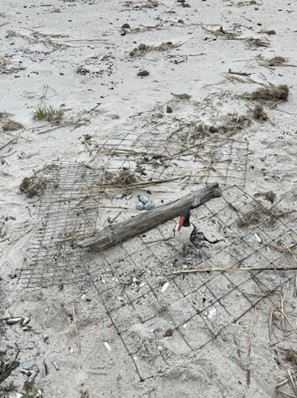

Since CWF recently started monitoring American oystercatchers on the Delaware Bay, the goal of our banding apprenticeship was to get me up to speed and comfortable banding oystercatchers. Before you can band oystercatchers, you have to capture them! Emily first taught me how to catch oystercatcher adults with a bownet, a trigger-loaded net that is placed over a pair’s nest (real eggs are removed and replaced with fake decoys to prevent breakage). Once the target bird returns to incubate the nest, we pull the trigger causing the net to flip over the bird so that we can extract it. I also learned another common capture method using a leg loop mat, which takes advantage of an oystercatcher pairs’ territorial behavior at their nest sites. Leg loop mats (constructed by tying microfilament loops to a wire mat are placed around a nest site) and oystercatcher decoys are staged near the mats. By playing audio lures of oystercatcher sounds on a speaker, we can trick the pair into thinking other birds are encroaching on their nest territory. As they approach the decoys and step on the mats, their legs will become stuck in the microfilament loops, and we can extract them. Unfledged chicks proved much easier to capture compared to adults thanks to a relatively new method introduced by Emily – a chick corral! After setting up a semicircle “fence”, a large group of people gradually form a circle around the chicks and guide them toward the fence, allowing for a quick and stress-free hand capture.


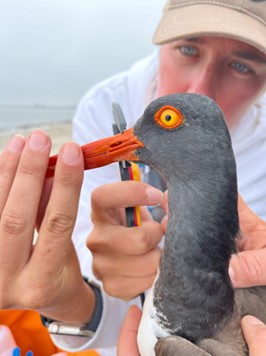
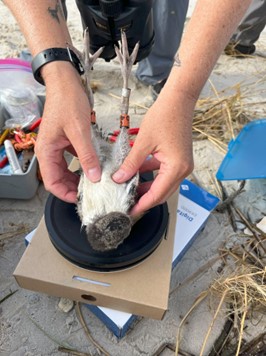
Once we had the birds in hand, Emily taught me how to carefully and thoughtfully attach bands to the birds’ legs. Oystercatchers receive a federally-issued metal band on their lower leg (by their foot) and two plastic color bands with a field readable alphanumeric code on their upper legs (above the knee). Despite being challenging to capture, oystercatchers are extremely docile while in hand, making them the perfect candidates for banding practice. The act of banding is relatively straightforward, but it is always important to handle the birds respectfully and inspect your work to make sure the bands fit well around the legs. In addition to banding, I also practiced collecting morphometric measurements such as culmen (bill) length, tarsus length, weight, and wing chord. These measurements can provide useful information about a bird (e.g., bill length indicates sex in oystercatchers), so consistent and accurate measurements are a must. After banding and measurements are all finished, the birds are quickly released back into their territory and ready to be re-sighted!

All in all, I assisted Emily and ENSP in capturing approximately 20 oystercatchers on the Atlantic Coast this summer, 12 of which I banded. Each banding opportunity was a valuable learning experience, but I came away with three main lessons listed below.
1. The patient bander gets the bird…sometimes! Capturing birds, especially oystercatchers, can require a lot of waiting and crossing fingers. Oystercatcher adults are naturally suspicious creatures, which means they are likely to question any foreign items around their nests. In order to minimize stress to the birds, we always abort a capture effort after a certain time period depending on the trapping method. Most of the time, oystercatchers tested our patience by “running down the clock” to the last minute before a successful capture. That said, sometimes the birds you are trying to capture are not going to cooperate, no matter how patient you are. More often than not, we left our capture attempts empty-handed when particularly suspicious birds refused to return to their nests. It’s important to treat every “failed” attempt as a learning experience and maintain a “you get what you get and you don’t get upset” mindset!
2. The bird’s safety is the number one priority. This is perhaps the most important lesson to keep in mind while banding. Bird banding is inherently exciting, but banders must adhere to a strict Code of Ethics that always prioritizes the birds’ safety and well-being. For example, capture methods like bow nets and leg loop mats have been diligently vetted by the American Oystercatcher Working Group for safety and effectiveness. It is also the bander’s responsibility to consider weather conditions (i.e., heat and wind), the surrounding environment (eg., busy beaches), and other potential stresses to the birds when making decisions regarding capture or banding. Time from capture to release is diligently monitored, ensuring work is done as efficiently as possible, and each bird is handled appropriately and respectfully.
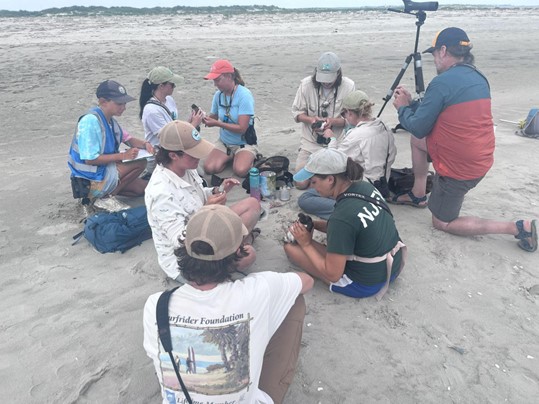
3. Teamwork makes the dream work. Capturing birds requires strong communication and teamwork skills. Everyone plays an important role, whether as a scribe, bander, bird handler, or bird spotter. We definitely would not have been able to capture and process as many birds as we did without the help and support of biologists, technicians, and volunteers. I have also found that banding is extremely collaborative with banders constantly sharing their expertise and techniques with each other. I sincerely appreciate all of the banders who shared their knowledge with me this season, and I am especially grateful to Emily Heiser for taking me under her wing this year as I start my banding career!
Discover more from Conserve Wildlife Foundation of NJ
Subscribe to get the latest posts sent to your email.